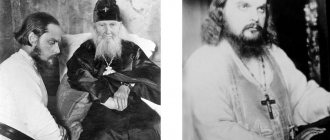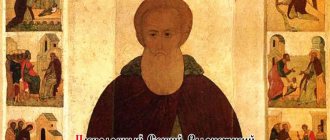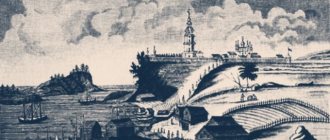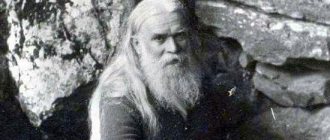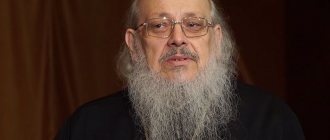| Ep. Afanasy (Sakharov) |
Afanasy (Sakharov)
(1887 - 1962), bishop b. Kovrovsky, vicar of the Vladimir diocese, confessor, saint Memory of October 15, in the Councils of the New Martyrs and Confessors of the Russian Church, the Land of Vladimir, Solovetsky, Radonezh, in the Council of Fathers of the Local Council of the Russian Church 1917-1918, as well as in the Councils of Vladimir, Moscow, Poltava (Ukr .) and Rostov-Yaroslavl saints
In the world, Sakharov Sergei Grigorievich, was born on July 2, 1887 in the village of Parevka, Kirsanovsky district, Tambov province, into the family of a Suzdal native, court councilor Grigory Petrovich and Matrona Andreevna, a peasant woman of the Tula province.
At the age of two he was left without a father. From an early age I fell in love with worship, especially the hierarchical service. Even as a child, he said about himself that he would be a bishop. His childhood and teenage years were spent in ancient Vladimir, which became his hometown.
In August 1896 he entered the Shuya Theological School. In 2nd grade there is a re-exam. I was in 3rd grade for 2 years.
In August 1899 he began serving at the altar.
In 1902 he entered the Vladimir Theological Seminary, from which he graduated in 1908. Almost all the time he served at bishop's services as a ripid bearer and subdeacon for Archbishop Nikolai (Nalimov).
On May 6, 1907, he was ordained a reader by the same bishop.
In 1908 he entered the Moscow Theological Academy, from which he graduated in 1912 in the second category with a candidate of theology degree.
Since October 6, 1912 - teacher at the Poltava Theological Seminary in pastoral subjects.
On October 12, 1912, he was tonsured a monk by the rector of the academy, Bishop Theodore (Pozdeevsky).
On October 14 of the same year he was ordained to the rank of hierodeacon and on October 17 to the rank of hieromonk.
On August 28, 1913, he was appointed caretaker of the Klevan Theological School of the Volyn diocese.
Since September 13 of the same year [1] - teacher at the Vladimir Theological Seminary in pastoral subjects.
In May 1917, he was a member of the Vladimir Diocesan Congress from the Vladimir Diocese of the Alexander Nevsky Brotherhood. At this congress he was elected from the monastic members of the All-Russian Congress of Clergy and Laity in Moscow and members of the Vladimir Diocesan Council.
At the monastic congress that took place in the Trinity Lavra, he was elected as a candidate member of the All-Russian Holy Council. On January 20, 1918, he joined the Local Council in place of Archimandrite Varlaam, rector of the Belogorodsky Monastery of the Perm Diocese, who resigned. At the Council he worked in the Departments on Divine Services, on Monasticism and on Church Discipline. He presented reports to the Department of Divine Services “On the preparation of a new edition of liturgical books with the inclusion of all existing both printed and handwritten services for Russian saints” and “On strengthening and legitimizing the honoring of local saints in dioceses.” He submitted a report to the Department on Church Discipline “On the assignment of liturgical distinctions to certain church servants and positions and the prohibition of distributing them as awards.” The latest report has been approved by the Division. At the plenary session he acted as a co-rapporteur on the report on the rules for the canonization of saints in the Russian Church. After the restoration of the Feast of All Saints in the Russian Land by the Council, he took part, together with the professor of Petrograd University Boris Turaev, in compiling the service for this holiday.
After the closure of the Council, he was a member of the Vladimir Diocesan Council from monastics from 1918 to 1920.
On January 20, 1920, he was elevated to the rank of archimandrite and appointed abbot of the Vladimir Monastery of the Nativity of the Blessed Virgin Mary.
As an assistant and devoted spiritual son, Fr. Afanasy was Yegor Sedov, a parishioner and then church warden of the church in the village of Lykova, Yuryev-Polsky district, Vladimir province. The circumstances of their acquaintance are unknown, but from the 1920s they kept in touch all their lives: they corresponded, Yegor Yegorovich supported Bishop Afanasy in prison by sending necessary things, food and money, and sent petitions for his release.
On July 1, 1921, he was appointed rector of the Bogolyubov Monastery.
July 10, 1921 [2] - with the blessing of Patriarch Tikhon, he was consecrated Bishop of Kovrov, vicar of the Vladimir diocese. The ordination at the Holy Cross Monastery of Nizhny Novgorod was performed by: Metropolitan of Vladimir and Shuisky Sergius (Stragorodsky); Archbishop of Nizhny Novgorod and Arzamas Evdokim (Meshchersky); and Bishop of Pechersk, vicar of the Nizhny Novgorod diocese Varnava (Belyaev).
March 17, 1922 - arrested and transported to the Revolution. tribunal. Released on March 18, 1922.
Arrested on March 30, 1922, Holy Wednesday. On May 27, 1922, a show trial was held on charges related to the seizure of church valuables. Sentenced to one year, released under amnesty on May 28, 1922.
Arrested on July 15, 1922. Released on July 25, 1922.
Arrested on September 10, 1922. Sentence: 2 years of exile in the Zyryansky region, starting from November 14, 1922.
Prisons: Vladimir, Moscow, Tagansk (bishop of FEODOSIA), Vyatka. Stages: September 10, 1922 - May 15, 1923.
Gave birth in the Zyryansky region: Ust-Sysolsk, Ust-Vym, village. Korchemye
In the people's court there was a retrial in the case of valuables, the verdict was 1 year in prison. In April 1924, the case was closed due to the length of time.
He stayed in the Zyryansky region without a sentence beyond the term of November 14, 1924 - January 20, 1925.
He returned to Vladimir for church work in February 1925.
September 8, 1925 - arrested in Gavrilov Posad while traveling around the diocese and transferred to Vladimir to clarify his identity. Released on September 10, 1925.
In the renovation magazine "Bulletin of the Holy Synod" there is a mention that Bishop Athanasius, unlike other Orthodox bishops, agreed to attend the diocesan congress, which was convened by the renovationists on September 15, 1925 to prepare for the III Local Council. However, from the further description of this event it is clear that he did not appear there as a participant, but rather as an accuser and accuser.
He did not take part in the prayer and did not bless the meeting, but only made a general bow and declared that he should not be at this meeting at all, and he appeared only at the strong request of the laity, and for this presence at the congress he should ask for forgiveness from Metropolitan Peter. After listening to the report on the upcoming council, Bishop Athanasius began to say that all renovationists must repent before the patriarch or his successor; that the Synodal (Renovationist) Church Administration is uncanonical and graceless; that newly ordained synodal bishops are not bishops, the consecrations they perform are not valid and those ordained by them must be re-ordained, which is what he, Bishop Athanasius, does. They (“old church members”) will not go to the council on October 1. For them, only a council convened by Metropolitan Peter would be authoritative. In case of sincere repentance, it will perhaps be possible to accept the Renovationists in their current rank. Having expressed all this, Bishop Athanasius left [3].
On January 15, 1926, he wrote an appeal to the Vladimir flock about non-recognition of the arbitrary Supreme Church Council headed by Archbishop Gregory (Yatskovsky) of Yekaterinburg. On the same day, he was arrested following a denunciation by priests associated with renovationism. One of them, Hieromonk Alexander (Chechel), arbitrarily appealed to the highest church authorities, and Archbishop Nikolai (Dobronravov), through His Eminence Athanasius, was forced to prohibit him from leaving Vladimir without the knowledge of the bishop located in the city. Bishop Afanasy was accused of misappropriating administrative rights, to which he replied:
«
In the fact that Archbishop Nicholas’s orders were conveyed to my hieromonk Chechel, one cannot see my appropriation of administrative or public legal functions, since at present all the bishop’s relations with the priests are exclusively based on the latter’s recognition of the moral authority of the former
«.
He was released on March 2, 1926.
In November of that year he was appointed manager of the Ivanovo diocese. In December of the same year, he was asked to leave the diocese or cease managing church affairs. Refused to leave the entrusted flock. To the remark: “If you are guilty, judge,” he received the answer: “It is not in our interest to judge you.”
He was arrested again on January 15, 1927 as a member of a group of bishops who used the Church for anti-Soviet purposes. From January 3 to April 30 of that year, he was in the Moscow internal prison.
For belonging to a group of bishops headed by Metropolitan Sergius (Stragorodsky) he was sentenced to three years in the Solovetsky camps. Leningrad transit prison - May 1927.
Solovetsky camps - Raznovoloka, Chupa Pristan, Popov Ostrov, Kem. Watchman, household accountant, watchman.
Arrested on December 23, 1929. Sent to the Solovetsky Islands on December 24, 1929. Returned to Popov Island on January 1, 1930.
He suffered from typhus in January - February 1930.
In the Solovetsky camps, according to the sentence, June 1927 - January 2, 1930. Without a sentence beyond the term - January 2 - February 23, 1930.
Transferred to Turukhansk region for 3 years. Prisons: Leningrad Crosses, Novosibirsk, Krasnoyarsk transit and internal - February 23 - April 23. Krasnoyarsk, Yeniseisk, Stanki, Turukhansk, Melnichnoe, Selivanikha, Punkovo.
Arrested in January 1930, he spent January - February 1932 in Turukhansk prison. Released in February 1932.
In the Turukhansk region, according to the verdict of April 30, 1932 - January 2, 1933. Without a sentence beyond the term - January 2 - August 6, 1933
From August 1935 to April 18, 1936 - returned to Vladimir, was free, but did not serve.
April 18, 1936 - arrested. Sentenced to 5 years in the White Sea-Baltic camps. Prisons: Vladimir, Ivanovo, internal and transit, Yaroslavl, Vologda, Leningrad transit, White Sea camps) November 1936 - June 1941.
He worked as a cash collector. For the money stolen from him, 1000 rubles. This amount was collected from him and a period of 1 year was added - December 1936 - January 1937.
He worked at a logging site, on the construction of a circular road, and as a foreman of a lap-weaving team.
In August 1937, he was arrested again without any charges being brought and imprisoned in a punishment cell. Released and returned to work at the end of October 1937.
Arrested without charge and imprisoned in a punishment cell at the beginning of November 1937. Released in December 1937. On the May holidays of 1938, imprisoned in a punishment cell.
At the beginning of the war he was transported to the Onega camps on foot about 400 km. June - July 1941
He was in prison: by sentence April 18, 1936 - April 18, 1942, without a sentence beyond the term of April 18, 1942 - June 30, 1942.
Indefinite deportation to the Omsk region. State farm Golyshmanovo - night watchman in the garden July - November 1942 G. Ishim December 1942 - November 1943
Arrested on November 7, 1943. Prisons: Ishimskaya, Omskaya, Moscow: internal, Lefortovo, Butyrskaya, Krasnopresnenskaya - November 1943 - July 1944.
Siberian camps: field work - August - September 1944. Vacuum truck September 1944 - August 1946
Arrested on August 30, 1946. Mariinsky transit point, Moscow prisons: internal, Butyrskaya, Krasnopresnenskaya August - September 1946.
Temnikov camps - weaving bast shoes. Dubrov, lag. - disabled person unemployed.
On March 5, 1952, at the end of his term of imprisonment, a Special Meeting at the USSR MGB adopted a resolution to release the bishop and send him to a home for the disabled under the supervision of the MGB. But only two years later, on May 18, 1954, the bishop was transported to the Zubovo-Polyansky home for the disabled.
Saint Athanasius Fr.
| Ep. Afanasy (Sakharov) and Sedov Egor Egorovich, 1954 |
The bishop's spiritual son and friend Yegor Sedov traveled to Moscow and worked for the release of Bishop Athanasius. Finally, in March 1955, he managed to take the completely ill Bishop Athanasius from the nursing home, taking him on bail. The bishop was completely exhausted and could barely walk. Yegor Egorovich brought him to Tutaev, to his home. The bishop lived in his house until the end of October.
| St. Afanasy (Sakharov). Icon |
The last years of Bishop's earthly life.
Afanasy lived in Petushki; these were years of seclusion and learned asceticism. Despite his advanced age and the labors and illnesses he had endured, he worked with youthful zeal to study Orthodox worship, the lives of Russian saints, and compiled a detailed work “on the commemoration of the dead according to the charter of the Orthodox Church.” As an expert in the liturgy of the Orthodox Church and Orthodox hagiography, since 1955 he worked as chairman of the Liturgical and Calendar Commission at the Publishing House of the Moscow Patriarchate and made many corrections to the calendar of saints. Before 1957, he had no published works; there were only drafts of various large articles.
Love, warmth and cordiality were felt by everyone who came into contact with the gracious archpastor. Conversations with him were fascinating.
Died on October 28, 1962 at 8:15 am. On Tuesday, October 30, in the house of the saint in Petushki, Abbot Kirill (Pavlov) celebrated a great requiem mass. The face of the deceased was bright and gracious, and the body did not have the slightest sign of decay.
The deceased archpastor left the following will:
«I earnestly ask my friends, spiritual children and everyone whom the Lord destined to serve at my burial that both the burial rite and all memorial prayers be performed, as far as possible, in strict compliance with all the rules of the church charter for the remembrance of the dead. In particular, I ask that on the eve of the burial there will be absolutely no so-called funeral vigil near my coffin. Let only the great requiem be celebrated with immaculate choruses and the full canon.
«.
The will was fulfilled. The funeral service in the Assumption Cathedral of Vladimir was performed by Archbishops Onisim (Festinatov) and Simon (Ivanovsky) co-served by 17 priests. The burial of the saint, which took place with such triumph and without obstacles from the authorities, was a miracle, testifying to his righteousness. Archpriest Vsevolod Shpiller, who returned to Russia in those years after many years of living abroad, said that “ there is no such saint as Bishop Athanasius in any of the Local Orthodox Churches.”
«.
He was buried at the Vvedensky cemetery near the Prince Vladimir Church in the city of Vladimir, to the left of his mother’s grave.
On March 21, 1989, he was rehabilitated by the prosecutor's office of the Vladimir region.
By a resolution of the Holy Synod of the Russian Orthodox Church dated July 18, 1999, the issue of canonization of the Right Reverend Athanasius (Sakharov) as new martyrs and confessors from the Vladimir diocese was submitted to the next Council of Bishops for consideration.
He was canonized on August 20, 2000. His relics were found on October 15, and on October 29 of the same year they were transferred in a religious procession to the Vladimir Nativity Monastery.
On October 15, 2012, in the city of Petushki, Vladimir Region, a memorial complex in memory of the priest was opened in the house of the saint, which includes a spiritual and educational center and an exhibition display.
About the bishop's stay Athanasius in the schism of “those who do not remember”
In the history of church schisms of the 20s and 30s of our century, Bishop. Afanasy is listed as a member of the so-called “Mechevsky” group of the Danilov schism, which condemned Metropolitan Sergius for the course he took in relation to Soviet power, and believed that the Church would ultimately find itself completely dependent on the atheistic state, and then there would be no possibility without sanctions of the civil authority neither to appoint nor to move bishops, but for bishops to freely govern the diocese and clergy.
According to supporters of this group, Metropolitan Sergius exceeded the rights given to him and thereby deprived himself of those legal rights that he received from Metropolitan Peter.
However, when Patriarch Sergius died and the management of the Church passed into the hands of Patriarch Alexy, Bishop Athanasius recognized the rights of this patriarch, despite the fact that he pursued the same course as his predecessor.
Bishop Afanasy's attitude to this issue can be understood from his letter dated May 22, 1955, which apparently was a guiding document for a large circle of people who trusted him. In this letter he writes:
“apart from the First Hierarch of the local Russian Church, none of us can be in communion with the Universal Church. Those who do not recognize their first hierarch remain outside the Church, from which may the Lord deliver us!”... “In the Church of Christ, grace is poured out and salvation is accomplished not by the clergy, but by the Church itself through the clergy. Priests are not the creators of grace, they are only dispensers of it, like channels... apart from which it is impossible to receive divine grace... The sacraments performed by unworthy clergy come to judgment and condemnation for the clergy, but to the grace-filled sanctification of those who receive them with faith. Only one circumstance - if a clergyman begins openly, publicly from the church pulpit to preach a heresy that has already been condemned at the Ecumenical Councils - not only gives the right, but also obliges everyone, clergy and laymen, without waiting for a council trial, to break off all communication with such a preacher, no matter what high position in the Church hierarchy he occupies...” “Patriarch Alexy and his associates do not preach heresies condemned by the fathers... Patriarch Alexy has not been condemned by any legitimate higher hierarchical authority, and I cannot, I do not have the right to say that he is graceless, and that the sacraments performed by him and his clergy are not valid . Therefore, when in 1945, while in prison, I and the priests who were with me, who did not remember Metropolitan Sergius, learned about the election and appointment of Patriarch Alexy, we discussed the situation that had arisen and decided in agreement that since, in addition to Patriarch Alexy, recognized by all the Ecumenical Patriarchs “, now there is no other legitimate first hierarch of the Russian local Church, then we must lift up the name of Patriarch Alexy in our prayers as our Patriarch, which I have been doing religiously since that day.”
Arguing completely Orthodox, logically and convincingly, until the speech concerns Patriarch Sergius, Bishop Athanasius begins to contradict himself as soon as he moves on to this topic, and immediately loses his usual consistency and prudence.
He seems to forget that Patriarch Sergius did not preach heresy and was not condemned by any legitimate higher church hierarchy, and having decided to elevate the name of Patriarch Alexy, Bishop. Afanasy does not find the strength to admit his previous position is erroneous. Citing a number of examples from the history of the Church, he draws attention to the fact that Christ Himself and the Apostles continued to go to the temple and take part in worship, despite the fact that it was performed by Jewish priests and high priests, whom they denounced. He mentioned the Patriarch of Constantinople in the 17th century, when the Turkish sultans appointed the patriarchate to the one who made the most contribution to the Sultan's treasury, but Christians still did not separate from their archpastors and shepherds, did not shy away from visiting churches where the names of the patriarchs appointed by the Sultan were exalted -Muslim. He also recalled what a temptation for the Orthodox Russian people was Peter’s associate, the leading member of the Synod, Archbishop Feofan (Prokopovich), whose behavior, perhaps, pushed other zealots into schism. He emphasized that it was not schismatics, but those who prayed in churches where the name of Theophan was exalted, who remained in the Orthodox Church and received grace and sanctification.
Everything in his letter is convincing and correct, but only to the point where he begins to justify his opposition to Patriarch Sergius, whom he always calls only Metropolitan.
Judging by this letter, Bishop. Athanasius at first recognized Metropolitan Sergius as the legitimate leader of church life, as the deputy of Metropolitan Peter, but changed his attitude towards him from the moment when Met. Sergius, through the ZhMP, stated that he, the deputy, “is vested with patriarchal power” and that Metropolitan Peter himself does not have the right “to interfere in the administration and correct even the mistakes of his deputy with his orders.” In this ep. Athanasius saw the illegal appropriation of all the rights of the first hierarch during the life of the legitimate canonical first hierarch, Metropolitan Peter, as if forgetting that Metropolitan Peter actually did not have the opportunity to govern the Church, so Metropolitan Sergius did not take away his power, but only performed his duties for him.
At Metropolitan Peter only had the title of Locum Tenens and the right to govern the Church in the event of his return, but to “correct the mistakes of his deputy” from afar, did not have detailed information about the actual situation of the Church - a completely different matter, and Metropolitan Sergius wrote precisely about such interference in his management.
All this is not difficult to understand, and one involuntarily catches the eye that Rev. Athanasius interprets the actions of Metropolitan. Sergius, in a different sense, justifies those who separated, despite the fact that the examples he gave indicate the inadmissibility of such separation from their archpastors, even those who received their power for money through Muslim sultans.
Such inconsistency indicates that Bishop Athanasius was full of deep-rooted dislike for Patriarch Sergius personally, and at the same time he was clearly aware of the need to restore normal relations with the Church and return his followers from the false spiritual path on which they found themselves.
Brief biographical information
Date of birth
: July 2, 1887
Place of birth
: s.
Parevka, Kirsanovsky district, Tambov province Took monastic vows
: October 12, 1912
Ordained deacon
: October 14, 1912
Ordained priest
: October 17, 1912
Ordained bishop of Kovrov
: July 10, 1921
Date of death
: October 28, 1962
Place death
: Petushki, Vladimir region
Bishop Afanasy (Sakharov), glorified as a saint and confessor in 2000, occupies a special place among the figures of the Russian Church of the 20th century.
An irreconcilable fighter against the schism of the “Living Church”, who refused to recognize the legality of Metropolitan Sergius (Stragorodsky) conferring the title of Metropolitan of Moscow and Kolomna in 1930 and became one of the most influential bishops of the “Catacomb” church, spiritually caring for a variety of communities of “non-rememberers”, he also 1945 recognizes the legality of the election of Patriarch Alexy I and calls on his spiritual children to do so.
Most of his episcopate, according to the “Dates and Stages of My Life” compiled by him (almost 30 out of 42 years) is spent in camps and exile; for another 10 years, including the last 8, he is free, but not in diocesan service. After being released from his last exile, the ruler finds himself forced to serve at home.
Sergei Iosifovich Fudel met Bishop. Afanasy in 1923, in his first exile. He was one of three bishops who attended the wedding of S.I. Fudel and Vera Maksimovna Sytina. Their spiritual communication continued even after the end of the Bishop’s last exile, when he, having settled in the town of Petushki, blessed the Fudely family to settle in the nearby town of Pokrov.
Proceedings
- The Mood of the Believing Soul according to the Lenten Triodion
, 1912 (PhD thesis). - “On the Six Psalms”, Journal of the Moscow Patriarchate
, 1957, No. 1, pp. 28-29. - On the commemoration of the dead according to the statutes of the Orthodox Church
, 1955 (typescript).
In manuscripts:
- “On the commemoration of the dead according to the Charter of the Orthodox Church.” Published in the journal of the Central European Exarchate “Voice of Orthodoxy” for 1962, No. 2.
- Several prayer sequences have been compiled, for example: “For those who want to walk through the air.” “About beings in different situations.” “Thanksgiving for receiving alms.” “About the peace of the whole world and the end of wars”, etc.
- A collection of new (over 100) magnifications and selected psalms.
- Die Furbitte fur die Verstorbenen nach den Ordnungen der orthodoxen Kirche, in: Std0 1962, 2, 40-45.
- O pominovenii usopsich po ustavu Pravoslavnoj Cerkvi, in: Vestnik Eksarchata 66(1969)103-129; 69(1970)38-63; 70/71 (1970)182-214; 73/74(1971)91-111; 75/76(1971)227-239; 77(1972)76-94, 178-188; 85/88(1974)201-274; 89/90(1975)117-129; 203-214; 93/96(1976)159-181.
- Mozno li posescat' chramy Moskovskoj Patriarchii, in: Vest. russ. chr. dv. 106(1972)92-97.
- Darf man die Kirchen des Moskauer Patriarchats besuchen? Aus dem Brief an seine geistliche Tochter, in: Ostkirchliche Studien 22(1973)327-332.
- Several prayer sequences.
- Zealot of the Glory of God: The Life and Works of the Confessor Bishop Athanasius (Sakharov) / Author-comp. G. Katyshev. M.: Sretensky Monastery Publishing House, 2006. 512 p.
Literature
- “Church. Ved." 1913, No. 36, p. 451.
- "ZhMP" 1957, No. 1, p. 28-29.
- “Church. and Life" (updated) 1922, No. 3, p. 5.
- "ZhMP" 1957, No. 2, p. 20, 1958, No. 11, p. 19, no. 12, p. 9, 1959, No. 1, p. 13, 1963, No. 3, p. 76-77.
- FPS I, no. 121, p. 5, III, p. 2.
- FAM I, no. 38, p. 4.
- “The name list is rector. and inspector. Spirit. Academician and seminaries for 1917,” p. 43.
- Letter from Bishop Athanasius dated May 9/22, 1955.
- Autobiography of Bishop Afanasy (Sakharov). "Vestn. Priest Synod" 1926, No. 7, p. 8.
- Archimandrite John (Snychev): “Church schisms of the 20s and 30s”, p. 384.
- Vest. russ. chr. dv. 81(1966)13-17.
- ZMP 1962, 12, 15-17.
- Es war noch vor der Loealitatserklarung Sergijs.
Time of arrests and exiles
Less than a year had passed since the day of his consecration, when on March 30, 1922, Archbishop Kovrovsky was arrested, but the first arrest of the bishop lasted only one day.
Important! A secret message from Lenin was found, which said that the destruction of a particularly active part of the priesthood could be carried out under the guise of the fight against hunger and the expropriation of valuables in churches.
In April, the Suzdal church case was fabricated, in which on April 12, Bishop Sakharov, Metropolitan Sergius (Stragorodsky), and Archbishop Pavel (Borisovsky) were charged with treason.
On false charges, for opposing the seizure of temple valuables, upon the discovery of the sacristy previously plundered by the Bolsheviks, the bishops were arrested. The Lord constantly showed His mercy towards Sakharov, who was sentenced to a year on June 9, 1922, and released a day later, because an amnesty was issued.
Priest Confessor Afanasy (Sakharov)
- For his active participation in the renovation movement, Archbishop Afanasy Kovrovsky Sakharov was arrested in mid-summer and late September 1922, sent to Moscow's Taganskaya prison, where he was sentenced to 2 years of exile in Ust-Sysolsk, Zyryansky region.
- After his release at the beginning of 1925, he returned to his hometown and assumed control of the diocese of the Vladimir region with the rank of first assistant to Nikolai (Dobronravov), an archbishop sent after his arrest to Moscow.
- May 1925 came, and the main political department demanded that Bishop Kovrovsky renounce control of the diocese in writing.
- In the fall of 1925, at the renovationist diocesan congress, Saint Athanasius showed dissatisfaction with the policies of the church and left it.
It turns out that the GPU had its own priests, so Bishop Damian (Voskresensky), the head of the Provisional Higher Church Council, moved from his place as governor of the Vladimir diocese and Athanasius, who took over the reins of government in the diocese, was placed under arrest.
On January 15, 1926, Archbishop of Kovrov, Vicar of Vladimir blessed the parishioners to live without the head of the diocese, advising them, if necessary, to seek help in neighboring dioceses, and was arrested for 2 months.
The repentant Bishop Damian (Voskresensky) again headed the Vladimir diocese, and Saint Afanasy Sakharov, Bishop of Kovrov in November 1926, headed the Ivanovo diocese.
Solovki
For refusing to stop managing the affairs of the diocese and leaving the region, he was again arrested on January 15, 1927 for anti-Soviet activities. This time, the bishop spends 4 months in a Moscow prison, after which a sentence was pronounced - 3 years in a camp on Solovki.
Since May 1927, the convicted Sakharov has worked as a watchman and accountant in Raznovoloka, Popov Island and other camps.
Icon of St. Athanasius, Bishop of Kovrov
At the end of December 1929, the disgraced priest was sent to Solovki, from where he returned a month later, on the eve of 1930, to Popov Island, where he was struck down by typhus. The barely strong saint is transported to prisons in the Krasnoyarsk and Turukhansk regions. The Turukhansk prison for 2 years became the place of life and trials of Bishop Kovrovsky.
On February 2, the saint was released in order to be sent to the Turun region on April 30 of the same year for almost a year and a half, until August 1933.
White Sea-Baltic link
Only from the end of the summer of 1935 until mid-April 1936 was the saint able to live in his hometown. He did not even conduct services, but was arrested again with a sentence of 5 years in the White Sea-Baltic camps until June 1941 for refusing to cooperate with Sergius, the pro-Soviet metropolitan.
He was appointed as a collector, and after the theft of money by criminals, he receives another year of exile. Logging, road construction, bast weaving brigade, the priest went through all the circles of hell, but was not shot, like many political prisoners.
When the Germans attacked, the exiled priests were transported to the Onega camp, forcing them to walk four hundred kilometers.
- After his release in the early summer of 1942, he was sent to his place of residence in Ishima, Omsk Region, where Vladyka worked at night as a watchman until the end of autumn 1943.
- The inability to remain silent and not preach the word of God again brought Afanasy Sakharov to the dock in November 1943; he was transported to Moscow and constantly interrogated, forcing him to again confess to the fight against the Soviets, to which the bishop refused.
- 1944 and eight years of life in the camps of Siberia and Temnikov, Mordovia. To further humiliate the priest, he is assigned to sewage work.
Until 1945, Saint Athanasius denied the legitimacy of Patriarch Sergius; he welcomed the arrival of Patriarch Alexy I, who in 1955 received Saint Kovrovsky, released due to disability in 1947.

